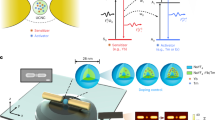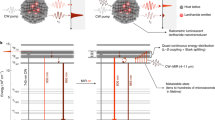Abstract
Upconversion nanocrystals convert infrared radiation to visible luminescence, and are promising for applications in biodetection1,2,3, bioimaging4,5,6,7, solar cells8,9,10 and three-dimensional display technologies8,9,11. Although the design of suitable nanocrystals has improved the performance of upconversion nanocrystals10,12,13,14, their emission brightness is limited by the low doping concentration of activator ions needed to avoid the luminescence quenching that occurs at high concentrations15,16. Here, we demonstrate that high excitation irradiance can alleviate concentration quenching in upconversion luminescence when combined with higher activator concentration, which can be increased from 0.5 mol% to 8 mol% Tm3+ in NaYF4. This leads to significantly enhanced luminescence signals, by up to a factor of 70. By using such bright nanocrystals, we demonstrate remote tracking of a single nanocrystal with a microstructured optical-fibre dip sensor. This represents a sensitivity improvement of three orders of magnitude over benchmark nanocrystals such as quantum dots17.
This is a preview of subscription content, access via your institution
Access options
Subscribe to this journal
Receive 12 print issues and online access
$259.00 per year
only $21.58 per issue
Buy this article
- Purchase on Springer Link
- Instant access to full article PDF
Prices may be subject to local taxes which are calculated during checkout





Similar content being viewed by others
References
Zhang, C., Yuan, Y., Zhang, S., Wang, Y. & Liu, Z. Biosensing platform based on fluorescence resonance energy transfer from upconverting nanocrystals to graphene oxide. Angew. Chem. Int. Ed. 50, 6851–6854 (2011).
Wu, S. W. et al. Non-blinking and photostable upconverted luminescence from single lanthanide-doped nanocrystals. Proc. Natl Acad. Sci. USA 106, 10917–10921 (2009).
Stepuk, A. et al. Use of NIR light and upconversion phosphors in light-curable polymers. Dental Mater. 28, 304–311 (2012).
Nyk, M., Kumar, R., Ohulchanskyy, T. Y., Bergey, E. J. & Prasad, P. N. High contrast in vitro and in vivo photoluminescence bioimaging using near infrared to near infrared up-conversion in Tm3+ and Yb3+ doped fluoride nanophosphors. Nano Lett. 8, 3834–3838 (2008).
Wang, M. et al. Immunolabeling and NIR-excited fluorescent imaging of HeLa cells by using NaYF4:Yb,Er upconversion nanoparticles. ACS Nano 3, 1580–1586 (2009).
Yang, Y. M. et al. In vitro and in vivo uncaging and bioluminescence imaging by using photocaged upconversion nanoparticles. Angew. Chem. Int. Ed. 51, 3125–3129 (2012).
Tian, G. et al. Mn2+ dopant-controlled synthesis of NaYF4:Yb/Er upconversion nanoparticles for in vivo imaging and drug delivery. Adv. Mater. 24, 1226–1231 (2012).
Haase, M. & Schäfer, H. Upconverting nanoparticles. Angew. Chem. Int. Ed. 50, 5808–5829 (2011).
Auzel, F. Upconversion and anti-Stokes processes with f and d ions in solids. Chem. Rev. 104, 139–173 (2004).
Zou, W. Q., Visser, C., Maduro, J. A., Pshenichnikov, M. S. & Hummelen, J. C. Broadband dye-sensitized upconversion of near-infrared light. Nature Photon. 6, 560–564 (2012).
Wang, F. et al. Simultaneous phase and size control of upconversion nanocrystals through lanthanide doping. Nature 463, 1061–1065 (2010).
Vetrone, F., Naccache, R., Mahalingam, V., Morgan, C. G. & Capobianco, J. A. The active-core/active-shell approach: a strategy to enhance the upconversion luminescence in lanthanide-doped nanoparticles. Adv. Funct. Mater. 19, 2924–2929 (2009).
Liu, X. et al. Breakthrough in concentration quenching threshold of upconversion luminescence via spatial separation of the emitter doping area for bio-applications. Chem. Commun. 47, 11957–11959 (2011).
Boyer, J. C. & van Veggel, F. C. Absolute quantum yield measurements of colloidal NaYF4: Er3+, Yb3+ upconverting nanoparticles. Nanoscale 2, 1417–1419 (2010).
Wang, F. & Liu, X. Upconversion multicolor fine-tuning: visible to near-infrared emission from lanthanide-doped NaYF4 nanoparticles. J. Am. Chem. Soc. 130, 5642–5643 (2008).
Zhang, H., Li, Y., Lin, Y., Huang, Y. & Duan, X. Composition tuning the upconversion emission in NaYF4:Yb/Tm hexaplate nanocrystals. Nanoscale 3, 963–966 (2011).
Schartner, E. P., Ebendorff-Heidepriem, H., Warren-Smith, S. C., White, R. T. & Monro, T. M. Driving down the detection limit in microstructured fiber-based chemical dip sensors. Sensors 11, 2961–2971 (2011).
Wang, F. et al. Tuning upconversion through energy migration in core–shell nanoparticles. Nature Mater. 10, 968–973 (2011).
Ye, X. C. et al. Morphologically controlled synthesis of colloidal upconversion nanophosphors and their shape-directed self-assembly. Proc. Natl Acad. Sci. USA 107, 22430–22435 (2010).
Yan, C., Dadvand, A., Rosei, F. & Perepichka, D. F. Near-IR photoresponse in new up-converting CdSe/NaYF4:Yb,Er nanoheterostructures. J. Am. Chem. Soc. 132, 8868–8869 (2010).
Gorris, H. H., Ali, R., Saleh, S. M. & Wolfbeis, O. S. Tuning the dual emission of photon-upconverting nanoparticles for ratiometric multiplexed encoding. Adv. Mater. 23, 1652–1655 (2011).
Wang, F., Wang, J. A. & Liu, X. G. Direct evidence of a surface quenching effect on size-dependent luminescence of upconversion nanoparticles. Angew. Chem. Int. Ed. 49, 7456–7460 (2010).
Mai, H. X., Zhang, Y. W., Sun, L. D. & Yan, C. H. Highly efficient multicolor up-conversion emissions and their mechanisms of monodisperse NaYF4:Yb,Er core and core/shell-structured nanocrystals. J. Phys. Chem. C 111, 13721–13729 (2007).
Priyam, A., Idris, N. M. & Zhang, Y. Gold nanoshell coated NaYF4 nanoparticles for simultaneously enhanced upconversion fluorescence and darkfield imaging. J. Mater. Chem. 22, 960–965 (2012).
Zhang, F. et al. Fabrication of Ag@SiO2@Y2O3:Er nanostructures for bioimaging: tuning of the upconversion fluorescence with silver nanoparticles. J. Am. Chem. Soc. 132, 2850–2851 (2010).
Yin, A., Zhang, Y., Sun, L. & Yan, C. Colloidal synthesis and blue based multicolor upconversion emissions of size and composition controlled monodisperse hexagonal NaYF4:Yb,Tm nanocrystals. Nanoscale 2, 953–959 (2010).
Mahalingam, V., Vetrone, F., Naccache, R., Speghini, A. & Capobianco, J. A. Colloidal Tm3+/Yb3+-doped LiYF4 nanocrystals: multiple luminescence spanning the UV to NIR regions via low-energy excitation. Adv. Mater. 21, 4025–4028 (2009).
Kramer, K. W. et al. Hexagonal sodium yttrium fluoride based green and blue emitting upconversion phosphors. Chem. Mater. 16, 1244–1251 (2004).
Liang, L. F., Wu, H., Hu, H. L., Wu, M. M. & Su, Q. Enhanced blue and green upconversion in hydrothermally synthesized hexagonal NaY1−xYbxF4:Ln3+. J. Alloys Comp. 368, 94–100 (2004).
Chen, X. & Song, Z. Study on six-photon and five-photon ultraviolet upconversion luminescence. J. Opt. Soc. Am. B 24, 965–971 (2007).
Chen, G. Y., Somesfalean, G., Zhang, Z. G., Sun, Q. & Wang, E. P. Ultraviolet upconversion fluorescence in rare-earth-ion-doped Y2O3 induced by infrared diode laser excitation. Opt. Lett. 32, 87–89 (2007).
Qin, G. S. et al. Intense ultraviolet upconversion luminescence from Yb3+ and Tm3+ codoped amorphous fluoride particles synthesized by pulsed laser ablation. Opt. Commun. 242, 215–219 (2004).
Lu, Y., Xi, P., Piper, J. A., Huo, Y. & Jin, D. Time-gated orthogonal scanning automated microscopy (OSAM) for high-speed cell detection and analysis. Sci. Rep. 2, 837 (2012).
Acknowledgements
The authors thank D. Birch, D. Inglis, N. Vella, A. Nadort, R. Field, M. Nguyen, D. Liu, C. Yan and J. Shen (Olympus Australia) for sample characterization, H. Ebendorff-Heidepriem for providing the suspended-core fibres, which were fabricated at the OptoFab node of the Australian National Fabrication Facility (ANFF), and A. Nechaev (Lomonosov Moscow State University of Fine Chemical Technologies, Russia) for bulk crystal preparation. J.Z. acknowledges a Macquarie University Research Excellence Scholarship, and D.J. and J.P. acknowledge support from the Australian Research Council (DP1095465, LP130100517). P.X. acknowledges support from the ‘973 program’ of China (2011CB707502, 2011CB809101) and T.M. acknowledges the support of an ARC Federation Fellowship.
Author information
Authors and Affiliations
Contributions
D.J. and T.M. conceived the project, designed the experiments and supervised the research. J.Z., E.S., Y.Lu and D.J. were primarily responsible for data collection and analysis. D.J., E.G., J.Z. and T.M. prepared figures and wrote the main manuscript text. J.Z., E.G., A.Z. and D.J. were primarily responsible for supporting information and numerical simulations. All authors contributed to data analysis, discussions and manuscript preparation.
Corresponding author
Ethics declarations
Competing interests
The authors declare no competing financial interests.
Supplementary information
Supplementary information
Supplementary Information (PDF 3204 kb)
Rights and permissions
About this article
Cite this article
Zhao, J., Jin, D., Schartner, E. et al. Single-nanocrystal sensitivity achieved by enhanced upconversion luminescence. Nature Nanotech 8, 729–734 (2013). https://doi.org/10.1038/nnano.2013.171
Received:
Accepted:
Published:
Issue Date:
DOI: https://doi.org/10.1038/nnano.2013.171
This article is cited by
-
Exploring luminescence quenching on lanthanide-doped nanoparticles through changing the spatial distribution of sensitizer and activator
Nano Research (2023)
-
Bioconjugates of photon-upconversion nanoparticles for cancer biomarker detection and imaging
Nature Protocols (2022)
-
Giant nonlinearity in upconversion nanoparticles
Nature Photonics (2022)
-
Achieving Multicolor Upconversion Emissions without Changing Compositions
Journal of Fluorescence (2022)
-
Yb- and Er concentration dependence of the upconversion luminescence of highly doped NaYF4:Yb,Er/NaYF4:Lu core/shell nanocrystals prepared by a water-free synthesis
Nano Research (2022)



